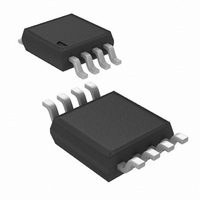LMH6504MM/NOPB National Semiconductor, LMH6504MM/NOPB Datasheet - Page 13

LMH6504MM/NOPB
Manufacturer Part Number
LMH6504MM/NOPB
Description
IC AMP VAR GAIN LOW POWER 8MSOP
Manufacturer
National Semiconductor
Series
LMH®r
Type
Variable Gain Amplifierr
Datasheet
1.LMH6504MMNOPB.pdf
(19 pages)
Specifications of LMH6504MM/NOPB
Amplifier Type
Variable Gain
Number Of Circuits
1
Slew Rate
1500 V/µs
-3db Bandwidth
150MHz
Current - Input Bias
1.4µA
Current - Supply
11mA
Current - Output / Channel
80mA
Voltage - Supply, Single/dual (±)
7 V ~ 12 V, ±3.5 V ~ 6 V
Operating Temperature
-40°C ~ 85°C
Mounting Type
Surface Mount
Package / Case
8-MSOP, Micro8™, 8-uMAX, 8-uSOP,
Number Of Channels
1
Number Of Elements
1
Power Supply Requirement
Dual
Input Resistance
7MOhm
Input Bias Current
3.5uA
Single Supply Voltage (typ)
Not RequiredV
Dual Supply Voltage (typ)
±5V
Power Supply Rejection Ratio
65dB
Rail/rail I/o Type
No
Single Supply Voltage (min)
Not RequiredV
Single Supply Voltage (max)
Not RequiredV
Dual Supply Voltage (min)
±3.5V
Dual Supply Voltage (max)
±6V
Operating Temp Range
-40C to 85C
Operating Temperature Classification
Industrial
Mounting
Surface Mount
Pin Count
8
Package Type
MSOP
Lead Free Status / RoHS Status
Lead free / RoHS Compliant
Output Type
-
Gain Bandwidth Product
-
Voltage - Input Offset
-
Lead Free Status / Rohs Status
Compliant
Other names
LMH6504MM
LMH6504MMTR
LMH6504MMTR
Available stocks
Company
Part Number
Manufacturer
Quantity
Price
Application Information
GAIN ACCURACY
Gain accuracy is defined as the actual gain compared
against the theoretical gain at a certain V
pressed in dB) (See Figure 2).
Theoretical gain is given by:
Eq. 3
Where K = 0.965 (nominal) N = 0.96V & V
temperature
For a V
the worst case accuracy over the entire range. The "Typical"
value would be the worst case difference between the "Typi-
cal gain" and the "Theoretical gain". The "Max" value would
be the worst case difference between the actual gain and the
"Theoretical gain" for the entire population.
GAIN MATCHING
Gain matching as the limit on gain variation at a certain V
(expressed in dB) (see Figure 2) and is specified as "Max"
only (no "Typical"). For a V
represents the worst case matching over the entire range.
The "Max" value would be the worst case difference between
the actual gain and the typical gain for the entire population.
FIGURE 2. LMH6504 Gain Accuracy & Gain Matching
G
range, the value specified in the tables represents
Defined
G
range, the value specified
C
(Continued)
= 80mV
G
(results ex-
20084351
@
room
G
13
GAIN PARTITIONING
If high levels of gain are needed, gain partitioning should be
considered:
The maximum gain range for this circuit is given by the
following equation:
Eq. 4
The LMH6624 is a low noise wideband voltage feedback
amplifier. Setting R
gain of 20 dB. Setting R
at 50Ω, produces a gain of about 26 dB in the LMH6504. The
total gain of this circuit is therefore approximately 46 dB. It is
important to understand that when partitioning to obtain high
levels of gain, very small signal levels will drive the amplifiers
to full scale output. For example, with 46 dB of gain, a 20 mV
signal at the input will drive the output of the LMH6624 to 200
mV, the output of the LMH6504 to 4V. Accordingly, the
designer must carefully consider the contributions of each
stage to the overall characteristics. Through gain partitioning
the designer is provided with an opportunity to optimize the
frequency response, noise, distortion, settling time, and
loading effects of each amplifier to achieve improved overall
performance.
LMH6504 GAIN CONTROL RANGE AND MINIMUM GAIN
Before discussing Gain Control Range, it is important to
understand the issues which limit it. The minimum gain of the
LMH6504, theoretically, is zero, but in practical circuits is
limited by the amount of feedthrough, here defined as the
gain when V
and package as well as coupling through the supplies will
determine the amount of feedthrough. Even at DC, the input
signal will not be completely rejected. At high frequencies
feedthrough will get worse because of its capacitive nature.
At frequencies below 10 MHz, the feed through will be less
than −60 dB and therefore, it can be said that with A
20 dB, the gain control range is 80 dB.
G
FIGURE 3. Gain Partitioning
= 0V. Capacitive coupling through the board
2
at 909Ω and R
F
at 1000Ω as recommended and R
1
at 100Ω produces a
www.national.com
20084352
VMAX
G
=











